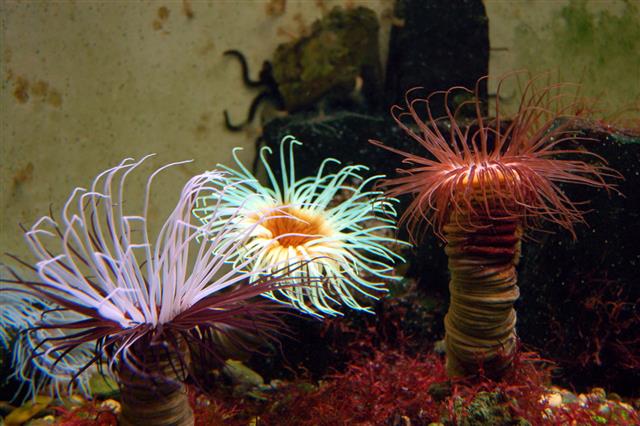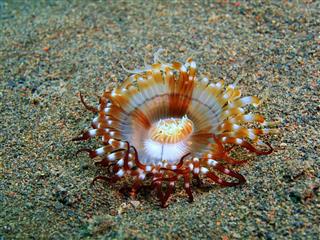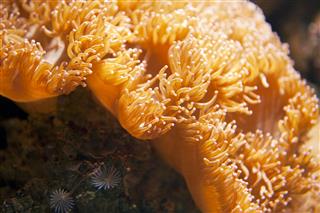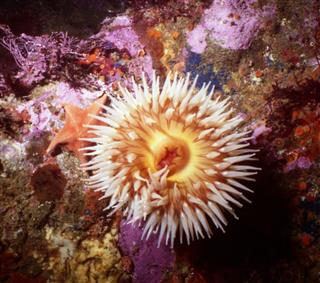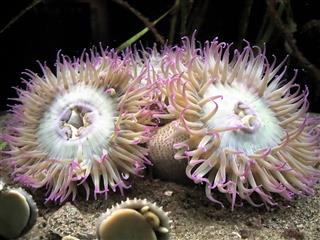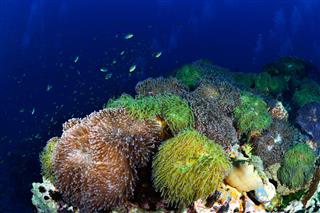
Sea anemones are water-dwelling predatory animals of the phylum Cnidaria. They are stinging polyps that spend major part of their lifetime attached to rocks at the bottom of the sea or on coral reefs. Sea anemones have a close resemblance to corals, jellyfish, tube-dwelling anemones, and hydra.
Sea anemones are colorful polyps named after equally colorful terrestrial flowers of the Anemone genus. They are water-dwelling, filter-feeding animals belonging to the Actiniaria order of the Anthozoa class in the phylum Cnidaria.
Sea anemones come in various sizes, ranging from less than 1¼ cm (½ in) to nearly 2 m (6 ft) in diameter. They lack locomotive ability and thus, spend most of their life attached to some rock. The only way they can change their habitat is by hitching a ride on a passing crab, or by detaching from the rock and dragging themselves in the water.
✦ A sea anemone shows typical anatomy of polyps, with a small sac attached to the bottom by an adhesive foot. It has a column-shaped body that ends in an oral disc. There is a cavity at the center, which acts as the mouth as well as anus, and is surrounded by numerous tentacles. These tentacles are equipped with many cnidocytes, i.e., the cells that are used for protection as well as for capturing prey.
✦ The stinging elements in cnidocytes are called nematocysts. In each nematocyst, there is a small vesicle filled with a toxic compound known as actinoporins, inner filament, and an external sensory hair. When some organism touches the hair, cell explosion occurs, firing a harpoon-like structure, which attaches to the organism and injects a small amount of venom. This gives the anemone its characteristic sting.
✦ The venom contains neurotoxins which help in capturing the prey by paralyzing it. It is then moved by the tentacles into the mouth for digestion, inside the gastrovascular cavity. The toxins also serve as a defense mechanism against potential predators when mixed with water.
✦ The internal anatomy of anemones is comparatively simple with a gastrovascular cavity and a single opening on outside, which functions as both, mouth and anus. There is a non-central, primitive nervous system, which coordinates the processes involved in maintaining homeostasis. It also coordinates the biochemical and physical responses to various stimuli.
✦ The muscles and nerves of anemones are simple as compared to other animals. Cells in the outer layer (epidermis) and the inner layer (gastrodermis) have microfilaments which together form contractile fibers. These cannot be considered as true muscles, as they are not freely suspended in the body cavity.
✦ Since skeleton is absent in anemone, the contractile cells pull against the gastrovascular cavity, which acts as a hydrostatic skeleton. The stability for this hydrostatic skeleton is provided by the anemone shutting its mouth closed, which keeps the gastrovascular cavity at a fixed volume, making it firmer.
✦ There are separate sexes in sea anemones. Some species are also hermaphrodites. Reproduction can take place sexually or asexually. In sexual reproduction, male releases a sperm stimulating the female to release eggs, and then fertilization occurs. The eggs or sperms are released through the mouth. Asexual reproduction occurs by budding, binary fission (division in halves), or pedal laceration. Pedal laceration is a process in which pieces of the pedal disc break off to regenerate into small anemones.
✦ In other cnidarians, larvae go through a free swimming stage called medusa. This stage is absent in anemones. The fertilized egg directly develops into a planula, which settles down and grows into a single anemone.
✦ Sea anemones establish symbiotic relationships with green algae, clownfish, and hermit crabs. They provide algae a haven and exposure to sunlight and in return, receive oxygen and sugar, which happen to be the byproducts of the algal photosynthesis, from it.
✦ As for their symbiotic relationship with clownfish and hermit crabs, sea anemones protect them from predators and get scraps of food from them in return.
More than 1,000 sea anemone species are found in the oceans and coastal reefs across the world. The largest and the most varied species are found in coastal tropical waters. Due to the lack of skeleton, most Actiniaria do not form hard parts that can be distinguished as fossils, but a few fossils do exist. The oldest known fossil of sea anemone is Mackenzia, from the Middle Cambrian Burgess Shale of Canada.
